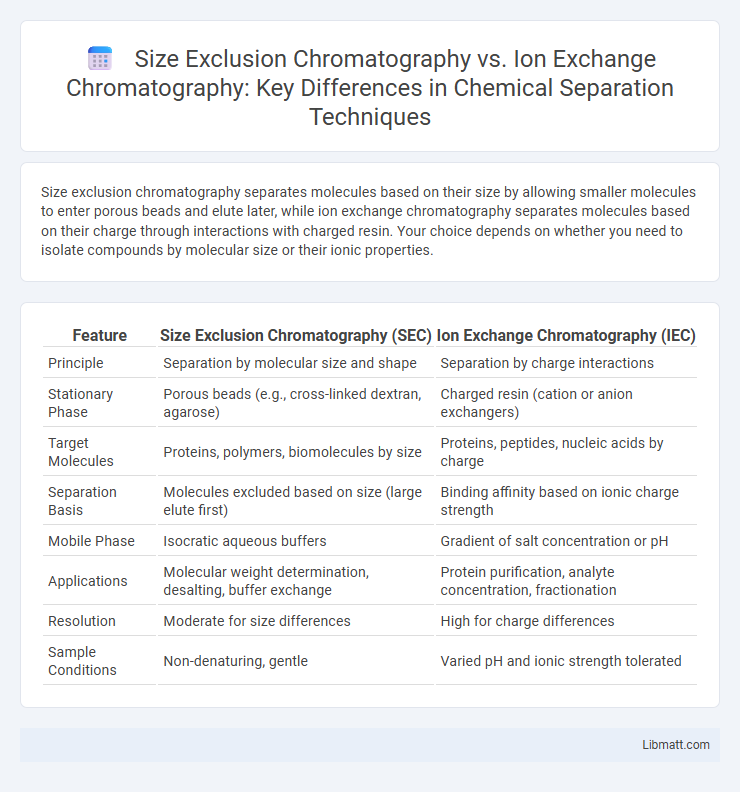Size exclusion chromatography separates molecules based on their size by allowing smaller molecules to enter porous beads and elute later, while ion exchange chromatography separates molecules based on their charge through interactions with charged resin. Your choice depends on whether you need to isolate compounds by molecular size or their ionic properties.
Table of Comparison
| Feature | Size Exclusion Chromatography (SEC) | Ion Exchange Chromatography (IEC) |
|---|---|---|
| Principle | Separation by molecular size and shape | Separation by charge interactions |
| Stationary Phase | Porous beads (e.g., cross-linked dextran, agarose) | Charged resin (cation or anion exchangers) |
| Target Molecules | Proteins, polymers, biomolecules by size | Proteins, peptides, nucleic acids by charge |
| Separation Basis | Molecules excluded based on size (large elute first) | Binding affinity based on ionic charge strength |
| Mobile Phase | Isocratic aqueous buffers | Gradient of salt concentration or pH |
| Applications | Molecular weight determination, desalting, buffer exchange | Protein purification, analyte concentration, fractionation |
| Resolution | Moderate for size differences | High for charge differences |
| Sample Conditions | Non-denaturing, gentle | Varied pH and ionic strength tolerated |
Introduction to Size Exclusion and Ion Exchange Chromatography
Size exclusion chromatography separates molecules based on their size by passing a sample through a porous matrix, allowing larger molecules to elute first while smaller molecules penetrate the pores and elute later. Ion exchange chromatography separates molecules based on their charge by using a charged resin that binds oppositely charged analytes, enabling selective retention and elution through changes in pH or ionic strength. Both techniques are widely used in protein purification, polymer analysis, and biochemical separations for their specificity in resolving complex mixtures.
Principle of Size Exclusion Chromatography
Size exclusion chromatography (SEC) separates molecules based on their hydrodynamic volume by allowing smaller molecules to enter porous beads in the stationary phase, causing delayed elution compared to larger molecules that bypass these pores. The principle relies on the differential accessibility of the stationary phase pores, enabling effective separation of proteins, polymers, and biomolecules by size without relying on charge or affinity. SEC is widely used for molecular weight determination, purification, and analysis of macromolecular aggregates.
Principle of Ion Exchange Chromatography
Ion exchange chromatography separates molecules based on their net charge by exploiting electrostatic interactions between charged analytes and oppositely charged functional groups immobilized on the stationary phase. This technique uses cation or anion exchangers to selectively bind positively or negatively charged biomolecules under specific pH and ionic strength conditions. Adjusting the salt concentration or pH of the mobile phase allows controlled elution of target compounds according to their charge properties.
Key Differences in Separation Mechanisms
Size exclusion chromatography separates molecules based on their size by allowing smaller molecules to enter porous beads, causing larger molecules to elute faster. Ion exchange chromatography separates molecules according to their net charge by binding oppositely charged ions to a charged resin and eluting them with salt gradients or pH changes. Your choice depends on whether molecular size or charge differences better suit the separation goals in your analytical or preparative process.
Sample Types and Applications
Size exclusion chromatography (SEC) is ideal for separating large biomolecules such as proteins, polysaccharides, and polymers based on molecular size, making it highly suitable for purity analysis and molecular weight determination. Ion exchange chromatography (IEX) excels in separating charged molecules like peptides, proteins, and nucleotides by exploiting their net charge differences, widely used in protein purification and quality control. Your choice depends on the sample's properties: SEC for size-based separation and IEX for charge-based purification applications.
Advantages of Size Exclusion Chromatography
Size exclusion chromatography offers the significant advantage of separating molecules based on size without relying on their charge, making it ideal for purifying proteins, polymers, and large biomolecules in their native states. This technique enables gentle separation, preserving biological activity and structure, which is often critical for downstream applications. Your samples benefit from minimal chemical interaction with the stationary phase, reducing the risk of denaturation or irreversible binding compared to ion exchange chromatography.
Advantages of Ion Exchange Chromatography
Ion exchange chromatography offers high selectivity based on charge differences, enabling efficient separation of closely related biomolecules such as proteins and nucleic acids. It allows for precise control over binding and elution conditions through pH and ionic strength adjustments, enhancing purification specificity. Your purification process benefits from its scalability and compatibility with large sample volumes, making ion exchange chromatography ideal for both analytical and preparative applications.
Limitations and Challenges
Size exclusion chromatography faces limitations in resolving molecules of similar size and is less effective for separating compounds with close molecular weights, while its accuracy diminishes with very large or very small molecules. Ion exchange chromatography challenges include sensitivity to pH and ionic strength variations, which can affect protein binding and elution, and complications arise when separating substances with similar charge properties. Your choice between these techniques should consider these constraints to optimize separation efficiency.
Choosing the Right Chromatography Technique
Size exclusion chromatography separates molecules based on their size and shape, ideal for purifying proteins or polymers without altering their charge properties. Ion exchange chromatography targets charged molecules, making it suited for separating proteins, peptides, or nucleic acids with different isoelectric points. Choosing the right technique depends on the sample's molecular characteristics and the desired separation resolution.
Conclusion: Size Exclusion vs Ion Exchange Chromatography
Size exclusion chromatography separates molecules based on size, enabling effective purification of macromolecules without altering their charge properties. Ion exchange chromatography relies on differential binding of charged molecules to a resin, offering high selectivity for proteins, peptides, and nucleic acids based on their charge at a given pH. Selecting size exclusion chromatography is ideal for buffer exchange and desalting, while ion exchange chromatography excels in targeted protein purification and resolving complex mixtures by charge.
size exclusion chromatography vs ion exchange chromatography Infographic

 libmatt.com
libmatt.com